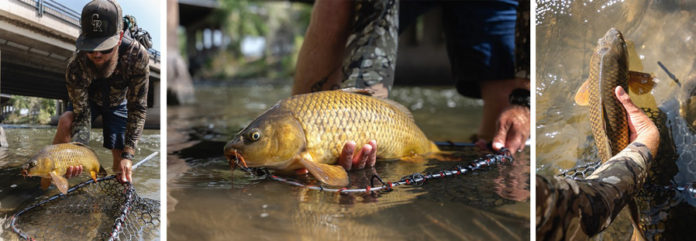Written by: Rick Mikesell, Trout’s Fly Shop
Photos by Ivan Orsic
In part 1 of the series, Rick discussed the importance of fly design and leader construction when fishing for carp in moving water on the Denver South Platte. Here, covers two essential presentations for river carp.
Perhaps because carp are so frequently called “poor man’s monefish,” anglers new to the species often imagine they’ll be stalking a wide-open flat, making long casts to drop flies right on the noses of tailing fish. While that ideal scenario may arise occasionally, it’s far more common that long casts and tight fly placements are detrimental to your success when fishing for carp in moving water.
Carp are excellent at avoiding predators, largely due to their keen hearing, which can detect movement at a considerable distance. Making a 60-foot cast to a carp would likely create enough commotion overhead to immediately put them on alert. The fly would have to land in a very precise spot, since most carp will move less than a foot to eat a fly. The problem is that these fish are easily spooked by a fly that lands within a foot of them. Fortunately, fishing for carp in moving water allows for some alternative presentations that don’t require expert precision:
1. The Drag and Drop
Cutting out traditional casting altogether can be the most productive way to catch carp feeding in skinny water near the bank. From the right position, you can simply lob your fly just past the fish, drag it across the surface film, and gently drop it into the feeding pocket, usually enticing an immediate bite. Approaching these fish quickly enough to get a shot, but quietly and inconspicuously enough to go undetected, is truly an art. Most days, I’m either hiding behind trees, or dressed as trees, decked out head-to-toe in camouflage.
2. The Swing
For carp feeding farther out, or surrounded by more complex currents, you can try swinging flies into the strike zone. In this scenario, you need to make an accurate cast, so practice is key. Make sure you’re proficient at loading the rod using as few false casts as possible, ideally just one. Cast the fly upstream and past the feeding fish, usually at least four to six feet beyond in both directions. Then, by raising the fly up into the surface film, you can control the “swing” of the fly in the current until it has moved in line with the fish. Upon releasing the tension, the current will push the fly down into the feeding pocket.

It takes some practice to release at the right time so that your fly hits the bottom in the ideal spot, which is 2-6 inches in front of the fish’s mouth. The timing will vary based on current speed and depth. Once your fly is in the pocket, you will benefit from both a tight line and upstream angle in relation to the fish, allowing you to slowly twitch the fly away as the fish approaches, triggering a predatory response. Remember, prey never swims toward a predator.
For those anglers fortunate enough to have a moving water carp fishery nearby, early spring is an excellent time to target river carp, as they will likely be at top pre-spawn weights and most aggressive feeding inclinations. The additional challenge of moving water makes the experience all the more engaging, and I hope the above tips help you land a personal best in the coming months. For more details on this topic, or to get inspired for your next trip, check out our video below on Fly-Fishing for Carp in the DSP.
Rick Mikesell is Chief Operations Manager at Trout’s Fly Shop in Denver, Colorado
Credit: Source link































